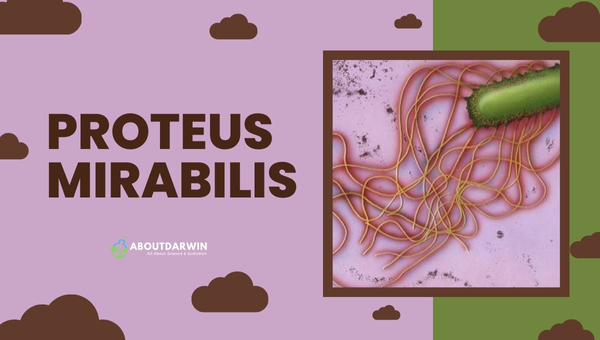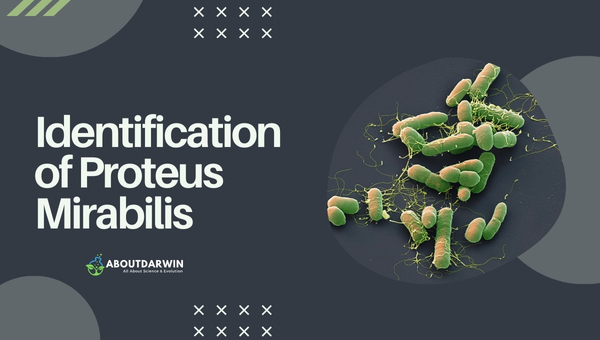Physical Address
304 North Cardinal St.
Dorchester Center, MA 02124
Every so often, I find myself amazed by the largely unseen world of microbiology. It’s a universe teeming with countless species, each playing its unique role in sustaining life.
Now, if you’re anything like me, new discoveries in this space can be both fascinating and crucial. This particularly rings true as we delve into understanding Proteus mirabilis, a bacterium that’s as interesting as it is infamous.
Proteus mirabilis is more than just another bacterium; it’s an integral part of our vast microbiological universe—it’s not that well-known but plays quite a significant role in the world of pathogens. Today, we’ll get ourselves acquainted with this intriguing organism and discuss how biochemical tests help identify Proteus mirabilis. Dive right in—the microscopic cosmos awaits!
Also Read: Streptococcus Pneumoniae: Identification & Biochemical Tests
Contents
Let me take you on an informative ride where I break this down for you—connecting the dots between the fundamental principles and particular properties of Proteus mirabilis.

| Basic Characteristics | Properties (Proteus mirabilis) |
|---|---|
| Catalase | Positive (+ve) |
| Indole | Negative (-ve) |
| Flagella | Positive (+ve) |
| Motility | Positive (+ve) |
| Shape | Rods |
| OF (Oxidative-Fermentative) | Facultative anaerobes |
| Gelatin Hydrolysis | Positive (+ve) |
| Growth in KCN | Positive (+ve) |
| Urease | Positive (+ve) |
| VP (Voges Proskauer) | Negative (-ve) |
| Nitrate Reduction | Positive (+ve) |
| MR (Methyl Red) | Positive (+ve) |
| Gas from Glucose | Positive (+ve) |
| Oxidase | Negative (-ve) |
| H2S | Positive (+ve) |
| Gelatin Hydrolysis | Positive (+ve) |
| Citrate | Positive (+ve) |
| Capsule | Negative (-ve) |
| DNase | Variable |
| Spore | Negative (-ve) |
| Gram Staining | Negative (-ve) |
| Pigment | Negative (-ve) |
| Shape | Rods |
| MR (Methyl Red) | Positive (+ve) |
| Indole | Negative (-ve) |
| VP (Voges Proskauer) | Negative (-ve) |
| Nitrate Reduction | Positive (+ve) |
| Citrate | Positive (+ve) |
| Gelatin Hydrolysis | Positive (+ve) |
| Urease | Positive (+ve) |
| Oxidase | Negative (-ve) |
| H2S | Positive (+ve) |
| Flagella | Positive (+ve) |
| Motility | Positive (+ve) |
| Capsule | Negative (-ve) |
| Growth in KCN | Positive (+ve) |
Proteus mirabilis is a fascinating bacterium, one that I’ve spent a lot of time studying and learning about. It’s a rod-shaped, Gram-negative bacteria commonly present in the environment around us.
Found in soil and water bodies, Proteus mirabilis is also known for being part of the human gut flora- those beneficial microbes we carry along with us in our digestive tracts.
However, it’s not just where it exists that defines Proteus mirabilis but also its capabilities. Unbelievably potent, this bacterium possesses flagella – long whip-like structures – on its body that allow it to move swiftly across surfaces.
Not only can it swim like an Olympic champ, but it can also group together to form what we call swarms. This swarming capability makes it quite problematic if the bacterium finds its way into environments where it shouldn’t be, like our urinary tract.
Breaking down the biochemistry of Proteus mirabilis has given me a deeper understanding of how this bacterium operates. Primarily, a biochemical test is used to identify key enzymes and metabolic properties that define Proteus mirabilis’ functionality and structure.
The tests offer illuminating insights into the bacterium’s identity. For instance, one prime way I differentiate Proteus mirabilis from other bacteria is through its ability to exhibit strong urease activity.
This enzyme breaks down urea, producing ammonia that raises urinary pH, leading to the formation of kidney stones. Trust me when I say that being able to identify traits unique to Proteus Mirabilis at such a granular level could be game-changing for anticipation and swift response initiatives.
Also Read: Unmasking Streptococcus Mutans: Role and Identification of the Bacterium
Here are the steps taken to carry out a biochemical test to spot Proteus mirabilis:
There you have it — biochemical testing for recognizing antimicrobial-resistance demonstrating bacterium like Proteus isn’t rocket science! Thinly sliced version, at least.
Have you ever walked into a room and instantly recognized an old friend? As it turns out, my microbiology lab experience isn’t much different. In scientific environments, the specific identification of a bacterium like Proteus mirabilis also works based on recognition- albeit of various biochemical properties and characteristics.

The primary method to identify Proteus mirabilis involves Gram Staining. This age-old technique allows me to differentiate between bacteria types based on the chemical and physical properties of their cell walls. For instance, when I’m looking for Proteus mirabilis, I’m specifically watching for rod-shaped entities with a negative Gram stain reaction.
Additionally, certain select biochemical tests can help confirm any presumptive identifications made by Gram staining alone. For example, the bacterial ability to ferment lactose is commonly measured using a MacConkey Agar test. In case you’re wondering: nope, Proteus mirabilis does not ferment lactose; its colonies will stay colorless on this agar plate.
However, what really seals the deal in identifying these bacteria is observing their ability to swarm en masse over surfaces or semisolids like agar; it’s almost as though they’re dancing around under my microscope! And that’s how I bring together a handful of tests (many more than mentioned here) to identify this nimble bacterium confidently.
Some modern technologies are mentioned below :
This has allowed us to view and study Proteus mirabilis in detail. Techniques like confocal microscopy even let us see the three-dimensional structures formed by these bacteria during swarming.
It has made it incredibly easier to identify variants or strains of Proteus mirabilis. By analyzing the unique genetic code of each strain, we can accurately identify and differentiate them.
Modern enzyme-linked immunosorbent assay (ELISA) kits are now available for rapid detection of Proteus mirabilis antigens in human samples, which makes diagnosis faster and more precise.
This is an innovative method that helps in identifying microbes based on their protein makeup.
This includes databases and applications that help organize, analyze, and interpret biological data. This technology has provided scientists with invaluable tools for classifying bacteria species, including Proteus mirabilis.
These advancements have not only made the identification process faster but also far more accurate. They’ve helped us understand this bacterium better, leading to improved strategies for infection control and treatment.
Also Read: Arteries and Veins: Understanding Differences and Impacts on Health
Navigating through the microbial world, it quickly becomes evident that prevention is definitely better than cure. Keeping Proteus mirabilis at bay, then, starts with some essential hygiene practices.
Regular hand washing, clean water, and basic sanitary measures can dramatically reduce the risk of any kind of infection, including those caused by this opportunistic bacterium.
Early detection is another critical component when it comes to control. The faster we identify an infection or a bacterial presence where it shouldn’t be, the quicker and more effectively we can take steps to tackle it.
Techniques like biochemical tests for Proteus mirabilis are crucial in such instances as they provide us with the necessary information on which antibiotics would be most effective against a given strain of bacteria.
Avoiding transmission of Proteus mirabilis can be accomplished in several ways:
The hydrolysis of urea forms the weak base, ammonia, as one of its products. This weak base raises the pH of the media above 8.4, and the pH indicator, phenol red, turns from yellow to pink.
Vulgaris is tested using the API 20E identification system it produces positive results for sulfur reduction, urease production, tryptophan deaminase production, indole production, sometimes positive gelatinase activity, and saccharose fermentation, and negative results for the remainder of the tests on the testing.
Proteus mirabilis is a Gram-negative, rod-shaped, motile bacterium that produces high levels of urease, a protein that hydrolyzes urea to ammonia. P. mirabilis can be detected in the lab by its unique characteristic of swarming when grown on agar plates. Additionally, this bacterium gives off a strong fishy odor.
Biochemical tests are used to identify bacterial species by differentiating them on the basis of biochemical activities.
In conclusion, understanding Proteus mirabilis and its biochemical test identification is crucial for everyone, not just those in the medical field. It’s an everyday part of our environment and, while typically harmless, can become a cause for concern if allowed to invade areas it isn’t meant to.
Lastly, remember that knowledge is power – being aware of Proteus mirabilis and understanding how it behaves can help prevent potential infections or complications down the line. Therefore, make sure you’re keeping up-to-date with information on this bacterium!
Upcoming technological advancements promise greater ease in identifying bacteria like Proteus mirabilis; who knows what fascinating discovery awaits us next? Until then, let’s continue keeping our focus on winning this microscopic war!